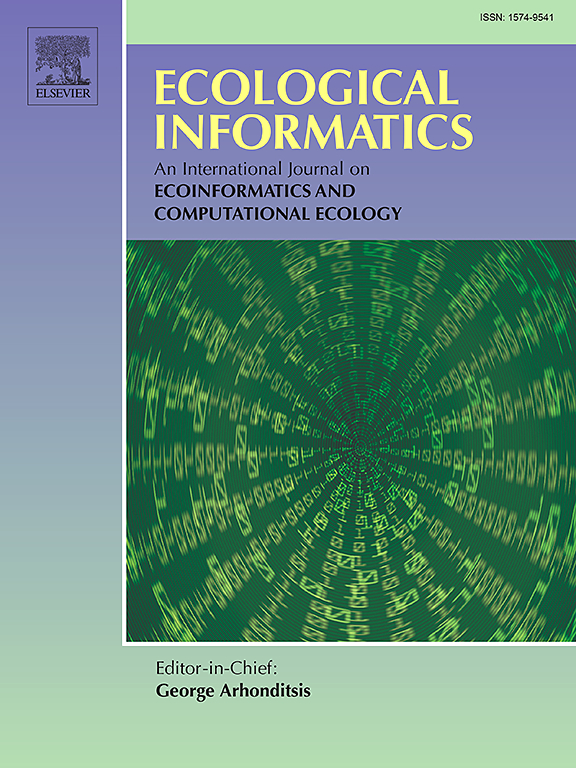基于深度学习的蜜蜂友好型树木遥感制图:一种增强传粉媒介保护的新方法
IF 5.8
2区 环境科学与生态学
Q1 ECOLOGY
引用次数: 0
摘要
鉴于蜜蜂作为传粉者的重要作用,全球野生蜜蜂数量的下降对生态系统的稳定构成了重大风险。保护蜜蜂友好的栖息地对于促进野生蜜蜂和防止进一步的损失至关重要,这需要对蜜蜂的生态有很好的了解。本研究探讨了德国布伦瑞克市地下筑巢蜜蜂安德列娜瓦加的筑巢地点与柳树分布之间的关系,柳树是这种蜜蜂和其他蜜蜂物种的重要花粉来源。我们的方法集成了多时相PlanetScope图像、表格转换器深度学习模型和lidar衍生的3D树模型,以自动绘制柳树树。该映射的F1得分为0.73(精度:0.69,召回率:0.78)。进行了实地调查,记录了安德列瓦加的巢聚集和聚集大小。平均而言,最近的Salix树位于距离聚集物150 m左右,而最近的5棵树位于300 m以内。文献指导下对给定聚集大小所需柳树密度的估计表明,平均而言,理论所需的树木数量在300米内,尽管有一个聚集的距离超过了1000米。虽然总体而言,巢群周围的柳树数量似乎随着巢群的大小而增加,但这种关系并没有被证明具有统计学意义。我们的研究说明了基于遥感的树种制图的潜力,可以增强我们对传粉媒介栖息地花卉资源可用性的了解,从而支持蜜蜂和其他昆虫的重要资源的知情保护。报告还强调了遥感技术的进步如何能够在生态研究和生境保护方面发挥重要作用。本文章由计算机程序翻译,如有差异,请以英文原文为准。

Deep learning based mapping of bee-friendly trees through remote sensing: A novel approach to enhance pollinator conservation
The global decline in wild bee populations poses significant risks to ecosystem stability given bees' essential role as pollinators. Conserving bee-friendly habitats is critical for the promotion of wild bees and prevention of further losses, which requires a good understanding of the bee's ecology. This study explores the relationship between nesting sites of the ground-nesting bee Andrena vaga and the distribution of Salix trees, an essential pollen source for this and other bee species, within the city of Braunschweig, Germany. Our approach integrates multi-temporal PlanetScope imagery, a tabular transformer deep learning model, and a LiDAR-derived 3D tree model to automate the mapping of Salix trees. The mapping achieved an F1 score of 0.73 (precision: 0.69, recall: 0.78). Field surveys were conducted, documenting Andrena vaga nest aggregations and aggregation sizes. On average, the nearest Salix tree was located approximately 150 m from an aggregation, while the nearest five trees were within 300 m. Literature-guided estimates of the required Salix density for a given aggregation size showed that, on average, the theoretically necessary number of trees was found within 300 m, though for one aggregation the distance exceeded 1000 m. While overall the number of Salix trees around nest aggregations seems to increase with aggregation size, the relationship did not prove to be statistically significant. Our study illustrates the potential of remote sensed based mapping of tree species to enhance our understanding of floral resource availability in pollinator habitats, thereby supporting informed conservation of essential resources for bees and other insects. It also highlights how advances in remote sensing can play an important role in ecological research and habitat conservation.
求助全文
通过发布文献求助,成功后即可免费获取论文全文。
去求助
来源期刊

Ecological Informatics
环境科学-生态学
CiteScore
8.30
自引率
11.80%
发文量
346
审稿时长
46 days
期刊介绍:
The journal Ecological Informatics is devoted to the publication of high quality, peer-reviewed articles on all aspects of computational ecology, data science and biogeography. The scope of the journal takes into account the data-intensive nature of ecology, the growing capacity of information technology to access, harness and leverage complex data as well as the critical need for informing sustainable management in view of global environmental and climate change.
The nature of the journal is interdisciplinary at the crossover between ecology and informatics. It focuses on novel concepts and techniques for image- and genome-based monitoring and interpretation, sensor- and multimedia-based data acquisition, internet-based data archiving and sharing, data assimilation, modelling and prediction of ecological data.
 求助内容:
求助内容: 应助结果提醒方式:
应助结果提醒方式:


